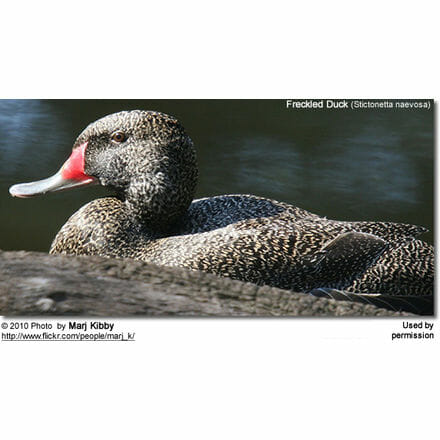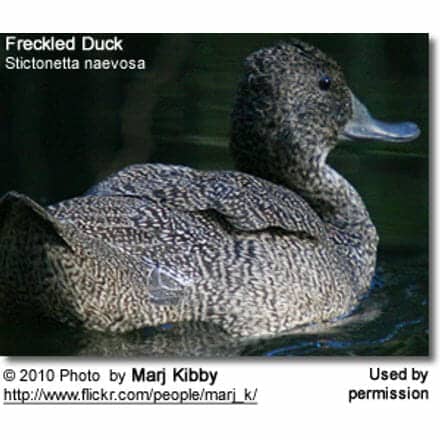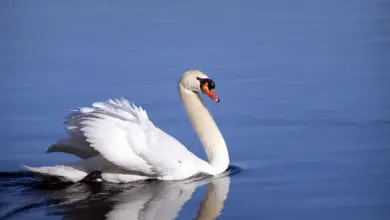Freckled Ducks
The Freckled Ducks (Stictonetta naevosa) is a moderately large, broad-bodied duck native to southern Australia. The duck is protected by law. Dark in colour with fine off-white speckles all over, it is most easily identified by its large head with a peaked (as opposed to rounded) crown.
This species was formerly allied with the dabbling ducks, but is now placed in a monotypic subfamily Stictonettinae. It appears to be part of an Gondwanan radiation of waterfowl, before true ducks evolved (Sraml et al. 1996).
The Freckled Duck feeds by dabbling in shallow water, often by wading near the edge. It prefers large, well-vegetated swamps, but moves to open water after breeding or in dry periods.
In flight, it has a distinctive rapid wing beat and holds its head low, making it look rather hunchbacked. It does not turn rapidly and lands clumsily.
In dry years, the ephemeral wetlands of the Murray-Darling Basin and Lake Eyre disappear and Freckled Ducks migrate to permanent water in coastal regions. This concentration in populated areas, coupled with their habit of circling repeatedly at low altitude when disturbed (even when being shot at) makes them particularly vulnerable to hunting.
Although protected by law in all states, the reality is that hunters continue to shoot Freckled Duck. During the 1979-83 drought, for example, the population was reduced by about 5%.
There have been steps taken to require shooters to pass a waterfowl identification test in Victoria (the state where, because of the nature of the wetlands, Freckled Duck are most vulnerable) and to make pre-season surveys of Freckled Duck numbers in wetlands so as to temporarily close areas to shooting, but it is too early to know how effective these changes will be.

In the longer-term, the key survival issue for Freckled Duck is likely to be habitat rather than hunting. Vast areas of former wetlands in the interior have been drained and cleared for agriculture, the remaining areas are threatened by salinity, by the diversion of water to supply cities and farms, and by long-term climate change: as rains come less often and higher average temperatures increase evaporation, Australia’s inland wetlands become less able to sustain life.
Hunter Wetlands Centre Australia has for the last 5 years had a breeding program to help ensure the survival of this vulnerable spieces. Recently the program has had some success with two successful hatchings (24 Ducks). Interested members of the public can view (and support) the freckled ducks at the Ramsar Convention protected wetlands.
More Duck Resources


Diet / Feeding
The Freckled Duck feeds by dabbling in shallow water, often by wading near the edge.
Ducks generally feed on larvae and pupae often found under rocks, as well as aquatic animals, plant material, seeds, small fish, snails and crabs.





